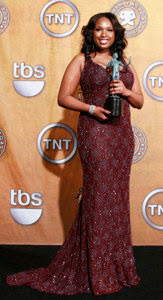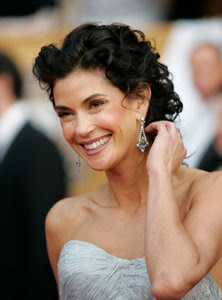Covering The SAGs
 Covering last weekend's Screen Actor's Guild Award (SAG) show at the Shrine Auditorium in Los Angeles took a lot of careful planning and work.
Covering last weekend's Screen Actor's Guild Award (SAG) show at the Shrine Auditorium in Los Angeles took a lot of careful planning and work.
It starts with trying to get access for the show.
Every show has a different criteria for who they allow to cover their event. There is an application process which every media outlet has to go through. It details what kind of access is needed and in what role each member has in covering the event.
Each news agency that wants to cover an Award Show must submit an application and carefully fill them out with an awareness for the deadlines for different shows. The Award Show organizers don't contact you to cover their event, you have to be proactive and find out when the show is, what are deadlines and how to cover them.
For a TV production, it can be an immense affair with talent, camera people, sound technicians, lighting grips, and carpenters building sets at different locations. The print wire services like the Associated Press, a team of editors, messengers and photographers descend on the day of the event.
For me, I'm it. I shoot, edit and transmit my photos which in turn are sent by my agency to publications around the world.
After your get an approval email, you can then start thinking how to cover the event.
One thing that is important if your a still photographer working for the magazines is what day the event is on. The SAGs was held on a Sunday. Many magazines finish editing or "close" on Monday. Sometimes if the event is huge, like the Oscars, they start editing the magazine that night and have editors laying out pages as soon as they get photos. That means you have to get your photos in front of those editors eyes ASAP or you won't see your photographs published that week. Different magazines close at different days of the week, so knowing what day is crucial to a photographer's success.
Luckily for me, the magazines did not have people working on Sunday so I sent my photos after the event and didn't have to worry about arranging for an on-site editor plus messenger to get my digital card to and from that editor from my shooting spots.
Photographers are granted access three areas for shooting at the SAG's. The Red Carpet, which is called arrivals, the press room, where winners of the awards pose after they win, and the show itself.
Most of what is televised of photographers are images of the Red Carpet where photographers are seen shouting at the stars trying to get their attention and pose in a certain way. The biggest reason why you see that is because for the most part video and still photography is mostly segregated except on the Red Capet. Plus it makes for good TV with all the photographer's flashes going off. At some awards shows and movie premieres, there is disco strobes installed to simulate photographer's flashes going off to give the Red Carpet the atmosphere of a big Hollywood spectacle.
There is a Red Carpet Protocol. It's the order of when and how movie stars walk down the Red Carpet. The Red Carpet "opens" for celebs about 2 hours before a show. First to walk down the Red Carpet are correspondents for the entertainment networks. They do the carpet first because it really the only time they have to get their photo taken as they will later have to interview the celebs. Next in line are minor actors, usually in supporting roles, or people that have to get into the theater early for the show because they have some kind of role during the show. Somewhere in the mix is a sponsor or in the case of the Oscars, guys from the accounting firm that counts the ballots with handcuffed suitcases attached. (Insert Big Corporate Logo)
Then around 30 minutes at the end, the big stars come out. Rapid fire, sometimes there is star grid-lock and if the star is big enough, they just get frustrated and avoid the press line and walk straight into the theater. The worst thing for a mid to low level celebrity is to walk near a big celeb and be totally ignored. If they are shrewd, they will come early and avoid that pitfall. The SAGs and most shows are televised live, so stars have to be in their seats by a certain time. But their is always a few stragglers. They don't care, there whole purpose is to get photographed and interviewed, the show is secondary especially if they are not presenters or nominees. At the Emmys in September, they closed the Red Carpet and told photographers that no one else was coming and the show was starting and all photographers had to go inside. Well, I did, and the photographers who dragged their feet got to shoot some really big stars that came very late.
The SAGs and most shows are televised live, so stars have to be in their seats by a certain time. But their is always a few stragglers. They don't care, there whole purpose is to get photographed and interviewed, the show is secondary especially if they are not presenters or nominees. At the Emmys in September, they closed the Red Carpet and told photographers that no one else was coming and the show was starting and all photographers had to go inside. Well, I did, and the photographers who dragged their feet got to shoot some really big stars that came very late.
Only a small handful of people are allowed to shoot the show itself. There is little space for photographers inside and they don't want a bunch of photographers shooting away, possibly making a disturbance. At the Golden Globes, only one photographer from NBC is allowed in, at the SAGs and Oscars, about six.
Ten to fifteen minutes into the show, the first awards are given out, and after they get their award, they are escorted backstage to get photographed and interviewed at various locales.
The entertainment TV shows produce elaborate sets where winners are interviewed. People Magazine, a sponsor of the SAGs sets up a make-shift studio with huge studio strobes and a back drop for portraits of the winners.
Then there is the press room for photographers. A little stage with taped areas where the winners are supposed to stand along with a long back drop, also called a "step and repeat" because celebs walk, stop, pose, and repeat. The winners pose with their trophy and photographers shout. Its a little noisy because it's indoors and the sound of 50-60 photographers shouting to look their way can be deafening. Not to mention the strobes of 50-60 cameras going off continually. You wonder how any hasn't gone into an epileptic fit.
A lot of photographers use an on camera strobe for the press room, but a light bar in the back of the room is set up for photographers to hang studio strobes. There is a huge difference in quality using the studio strobes. I mount two Dyna-Lite Uni 400 mono-lights that are plugged in and are triggered by Pocket Wizards. Doing so also means that I have to lug a lot more equipment to the show and show up extra early to mount and test them and stay late to take them down and pack them.
At the Oscars, photographers will come a day early to mount their strobes in the press room as light bar gets filled very quickly and room for more strobe heads are gone.
The most secure way is to have all your strobes hardwired and to have the packs under your seat at the press room. That way if there is a problem, the packs are right next to your and your sync cord is short. I try to keep it simple with the small self-contained flashes and the radio Pocket Wizards. I can leave my seat if I have to and if I'm using multiple cameras, at the SAGs I used three, there is no wires to tangle up.
The SAGS are a good show to shoot. You get to shoot stars from both TV and Film. The show itself is short. No long parade of winners of obscure awards.
It may have been a short show of only two hours, but is was a long day for me. I started my day at 8:00 a.m. Got my tuxedo in order, the show is black-tie, packed one rolling bag full of equipment with three cameras, three lenses and five Pocket-Wizards, one hard Pelican case with my Dyna-Lites, and another bag with my laptop and other computer equipment. Loaded the car and drove to the Shrine, set up the strobes and tested them, and then staked out my spot on the Red Carpet. At the press room I did a preliminary edit on my computer of arrivals, then after the show changed into jeans and a sweatshirt and drove two blocks to the local Starbucks, where I transmitted photos until they closed at 1 a.m. Drove home and then did a second edit and transmitted more photos until 5:30 a.m. That's over 21 hours of work for the day.

No comments:
Post a Comment